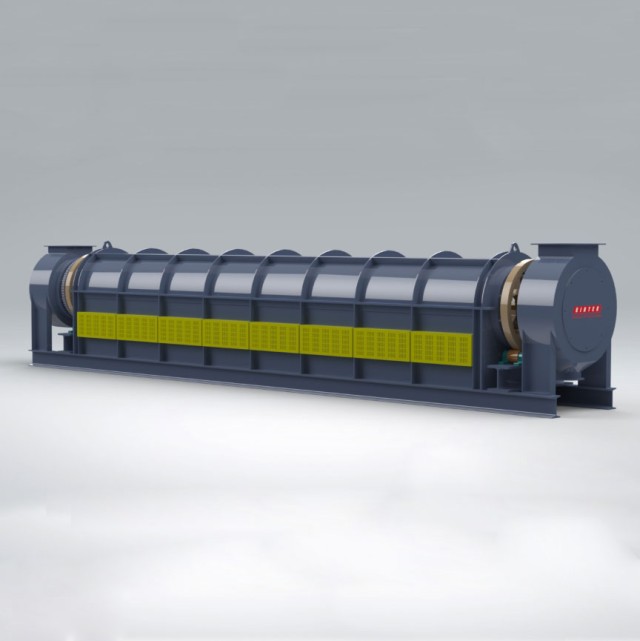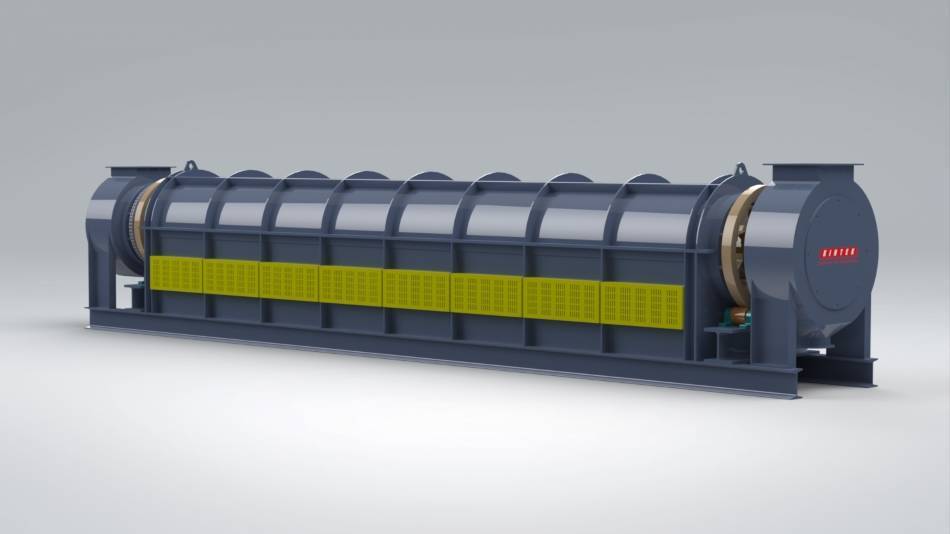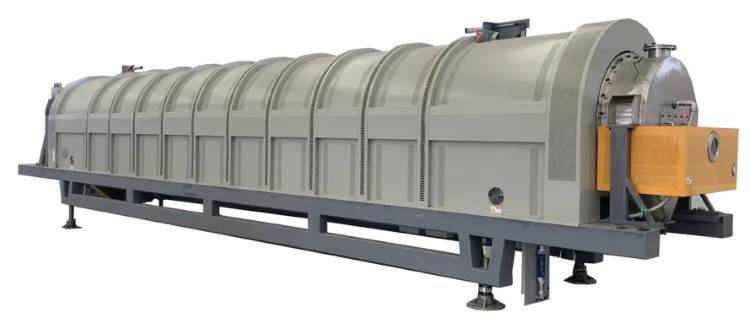
Electric Rotary Kiln
Electric Rotary Kiln Pyrolysis Furnace Plant Machine Calciner Small Rotary Kiln Rotating Furnace
Item Number : KT-RKTF
Price varies based on specs and customizations
- Tube diameter
- 0.6-1.2 m
- Tube length
- 7-12 m
- Heating zones
- 4 independent hot zones
- Work temperature
- < 1100 ℃
- Rotary drum angle
- 0-3 degree
Shipping:
Contact us to get shipping details Enjoy On-time Dispatch Guarantee.
Why Choose Us
Easy ordering process, quality products, and dedicated support for your business success.
Introduction
Electric Rotary Kiln Pyrolysis Furnace Plant Pyrolysis Machine Electric Rotary Calciner is a type of external heating rotary furnace that utilizes clean electricity as its heating source. It features precise temperature control and finds extensive applications in the calcination and drying of various materials, including positive and negative electrode materials, rare earth materials, chemical catalytic materials, magnetic materials, powder metallurgy materials, nonferrous metal materials, kaolin non-metallic mineral materials, and more. The rotary tube is constructed from nickel-based alloys, enabling working temperatures of up to 1100℃. Variable speed electric motors control the rotation speed of the drum, while hydraulic tilting facilitates material movement and effortless discharging. High-accuracy PID intelligent thermal controllers and superior quality Silicon Carbide (SiC) heating elements ensure efficient and reliable heating. The furnace's advanced design offers energy savings, environmental friendliness, and ease of maintenance, making it a versatile solution for various industrial applications.
Applications
Electric heating rotary kilns are widely used in various industries for thermal treatment processes, including:
- Calcination and drying of positive and negative electrode materials
- Rare earth materials
- Chemical catalytic materials
- Magnetic materials
- Powder metallurgy materials
- Nonferrous metal materials
- Kaolin non-metallic mineral materials
- High-temperature reaction
- Heat treatment
- Carbonization
Principle
Electric Rotary Kiln Pyrolysis Furnace Plant Pyrolysis Machine Electric Rotary Calciner is a type of rotary kiln that uses electricity as its heat source. The kiln consists of a rotating cylindrical chamber that is heated by electric heaters. The material to be processed is fed into the kiln and is heated as it passes through the chamber. The high temperatures cause the material to undergo pyrolysis, a process in which it is broken down into its constituent components. The resulting products are then collected and separated.
Electric Rotary Kiln Pyrolysis Furnace Plant Pyrolysis Machine Electric Rotary Calciner is used in a variety of applications, including the production of chemicals, pharmaceuticals, and food. It is also used in the recycling of waste materials, such as tires and plastics.





Electric rotary Kiln by KinTek
The rotary tube of electric rotary kiln is fabricated by the nickel based alloys, which working temperature is up to 1100℃; different drum diameter and length can be fabricated according to the target materials handling capacity, multi independent heating zones will be designed according to the production requirement; the speed of rotary drum applies variable speed electric motor, easy to control the rotating speed;The horizontal drum can be tilted by hydraulic for materials movement control and easy discharging; Temperature controller applies high accurate PID intelligent thermal controller, electric heaters are superior quality Silicon Carbide(SiC) heating element, features durable service life and easy maintenance.
Features
The Electric Rotary Kiln Pyrolysis Furnace Plant Pyrolysis Machine Electric Rotary Calciner offers a range of benefits that make it an ideal choice for various industrial applications. These include:
- High-speed electric heating: Reduces furnace downtime and energy consumption.
- Intelligent PID thermal control: Ensures precise temperature control and monitoring.
- Nickel-based alloy furnace tube: Provides high-temperature resistance and corrosion protection.
- Superior quality Silicon Carbide heating element: Offers extended service life and easy maintenance.
- Excellent dynamic sealing technology: Prevents material oxidation in inert gas environments.
- Advanced technological innovations: Incorporates hydraulic block wheel device, high-precision metering piston pump, speed control valve, and contact graphite block sealing device for stable performance and high yield.
Advantages
- High thermal efficiency: No smoke, no ash, and slag to take away obvious heat.
- Precise temperature control: Kiln temperature control accuracy is high, suitable for narrow pre-firing temperature processes.
- Easy automation: Conditions can be automatically controlled.
- No fuel storage or transportation required: Simplifies fuel procurement, transportation, and safety management.
- Reduced corrosion and environmental pollution: Avoids corrosion of the kiln body due to SO2 gas and environmental pollution problems.
- Cost-effectiveness: More economical than gas or oil fuel rotary kilns.
- High-temperature resistance: Nickel-based alloy furnace tube can withstand temperatures up to 1100℃ without deformation.
- Durable heating elements: Superior quality Silicon Carbide (SiC) hearing element ensures long service life and trouble-free maintenance.
- Excellent sealing: Dynamic sealing technology allows for operation under controlled inert gas protecting environment, preventing material oxidization.
- Intelligent control: Touch screen controller with intelligent PID thermal control technology, over temperature and temperature sensor broken alarming, multi heating program saving and easy switching, historical heating data analysis and research capabilities.
Technical specifications
| Model | KT-RKTF60 | KT-RKTF80 | KT-RKTF100 | KT-RKTF120 |
|---|---|---|---|---|
| Tube diameter | 0.6m | 0.8m | 1m | 1.2m |
| Tube length | 7m | 9m | 10m | 12m |
| Tube material | Nickel based alloy | |||
| Heating zones | 4 independent hot zones | |||
| Work temperature | < 1100℃ | |||
| Rotary drum angle | 0-3 degree | |||
| Insulation material | Polycrystalline ceramic fiber | |||
| Temperature controller | Touch screen PID controller with PLC | |||
| Heating element | Silicon Carbide (SiC) | |||
| Temperature sensor | Armed K type thermal couple | |||
| Electric power supply | AC220-440V,50/60HZ | |||
Warnings
Operator safety is the top important issue! Please operate the equipment with cautions. Working with inflammable& explosive or toxic gases is very dangerous, operators must take all necessary precautions before starting the equipment. Working with positive pressure inside the reactors or chambers is dangerous, operator must fellow the safety procedures strictly. Extra caution must also be taken when operating with air-reactive materials, especially under vacuum. A leak can draw air into the apparatus and cause a violent reaction to occur.
Designed for You
KinTek provide deep custom made service and equipment to worldwide customers, our specialized teamwork and rich experienced engineers are capable to undertake the custom tailoring hardware and software equipment requirements, and help our customer to build up the exclusive and personalized equipment and solution!
Would you please drop your ideas to us, our engineers are ready for you now!
FAQ
What Is A Pyrolysis Plant?
What Is Electric Rotary Kiln?
What Types Of Materials Can Be Processed In A Rotary Furnace?
What Is A Pyrolysis Furnace?
How Does A Pyrolysis Plant Work?
How Does A Electric Rotary Kiln Work?
What Are The Rotary Furnace Types?
How Does A Pyrolysis Furnace Work?
What Are The Main Applications Of Pyrolysis Plants?
What Are The Advantages Of Electric Rotary Kiln?
What Are The Advantages Of Rotor Furnace?
What Are The Applications Of Pyrolysis Furnaces?
What Can Electric Rotary Kiln Be Used For?
What Is The Efficiency Of A Rotary Furnace?
What Are The Advantages Of Using Pyrolysis Furnaces?
Can A Rotary Furnace Be Used For Continuous Production?
What Factors Should Be Considered When Selecting A Pyrolysis Furnace?
How Can The Performance Of A Rotary Furnace Be Optimized?
What Safety Precautions Should Be Followed When Using A Pyrolysis Furnace?
4.8 / 5
The electric rotary kiln furnace is an excellent choice for pyrolysis. It's energy-efficient, easy to control, and produces high-quality products.
4.9 / 5
I'm very impressed with the quality and performance of the electric rotary kiln furnace. It's a great investment for our laboratory.
4.7 / 5
The electric rotary kiln furnace is a valuable addition to our laboratory. It's easy to operate and maintain, and it produces consistent results.
4.6 / 5
I highly recommend the electric rotary kiln furnace for anyone looking for a reliable and efficient pyrolysis solution.
4.8 / 5
The electric rotary kiln furnace is a great choice for small-scale pyrolysis applications. It's easy to set up and operate, and it produces high-quality results.
4.7 / 5
I'm very satisfied with the electric rotary kiln furnace. It's a well-made and durable product that meets all of our needs.
4.9 / 5
The electric rotary kiln furnace is a great value for the price. It's a high-quality product that's built to last.
4.8 / 5
I'm very impressed with the customer service from KINTEK SOLUTION. They were very helpful and responsive to all of my questions.
4.7 / 5
The electric rotary kiln furnace arrived quickly and was easy to set up. I'm very happy with the overall experience.
4.9 / 5
I highly recommend the electric rotary kiln furnace to anyone looking for a reliable and efficient pyrolysis solution.
4.6 / 5
The electric rotary kiln furnace is a great choice for laboratory-scale pyrolysis. It's easy to operate and maintain, and it produces high-quality results.
4.8 / 5
I'm very satisfied with the electric rotary kiln furnace. It's a well-made and durable product that meets all of our needs.
REQUEST A QUOTE
Our professional team will reply to you within one business day. Please feel free to contact us!
Related Products

Electric Rotary Kiln Continuous Working Small Rotary Furnace Heating Pyrolysis Plant
Efficiently calcine and dry bulk powder and lump fluid materials with an electric heating rotary furnace. Ideal for processing lithium ion battery materials and more.

Electric Rotary Kiln Small Rotary Furnace Biomass Pyrolysis Plant
Learn about Rotary Biomass Pyrolysis Furnaces & how they decompose organic material at high temps without oxygen. Use for biofuels, waste processing, chemicals & more.

Electric Rotary Kiln Small Rotary Furnace for Activated Carbon Regeneration
Revitalize your activated carbon with KinTek's Electric Regeneration Furnace. Achieve efficient and cost-effective regeneration with our highly automated rotary kiln and intelligent thermal controller.

Vacuum Sealed Continuous Working Rotary Tube Furnace Rotating Tube Furnace
Experience efficient material processing with our vacuum-sealed rotary tube furnace. Perfect for experiments or industrial production, equipped with optional features for controlled feeding and optimized results. Order now.

Inclined Rotary Plasma Enhanced Chemical Vapor Deposition PECVD Equipment Tube Furnace Machine
Introducing our inclined rotary PECVD furnace for precise thin film deposition. Enjoy automatic matching source, PID programmable temperature control, and high accuracy MFC mass flowmeter control. Built-in safety features for peace of mind.

Rotary Tube Furnace Split Multi Heating Zone Rotating Tube Furnace
Multi zone rotary furnace for high-precision temperature control with 2-8 independent heating zones. Ideal for lithium ion battery electrode materials and high-temperature reactions. Can work under vacuum and controlled atmosphere.

Multi Heating Zones CVD Tube Furnace Machine Chemical Vapor Deposition Chamber System Equipment
KT-CTF14 Multi Heating Zones CVD Furnace - Precise Temperature Control and Gas Flow for Advanced Applications. Max temp up to 1200℃, 4 channels MFC mass flow meter, and 7" TFT touch screen controller.

Laboratory Vacuum Tilt Rotary Tube Furnace Rotating Tube Furnace
Discover the versatility of Laboratory Rotary Furnace: Ideal for calcination, drying, sintering, and high-temperature reactions. Adjustable rotating and tilting functions for optimal heating. Suitable for vacuum and controlled atmosphere environments. Learn more now!

Inclined Rotary Plasma Enhanced Chemical Vapor Deposition PECVD Equipment Tube Furnace Machine
Upgrade your coating process with PECVD coating equipment. Ideal for LED, power semiconductors, MEMS and more. Deposits high-quality solid films at low temps.

Laboratory Rapid Thermal Processing (RTP) Quartz Tube Furnace
Get lightning-fast heating with our RTP Rapid Heating Tube Furnace. Designed for precise, high-speed heating and cooling with convenient sliding rail and TFT touch screen controller. Order now for ideal thermal processing!

Dental Porcelain Zirconia Sintering Ceramic Vacuum Press Furnace
Get precise dental results with Dental Vacuum Press Furnace. Automatic temperature calibration, low noise tray, and touch screen operation. Order now!

Electrolytic Electrochemical Cell Gas Diffusion Liquid Flow Reaction Cell
Looking for a high-quality gas diffusion electrolysis cell? Our liquid flow reaction cell boasts exceptional corrosion resistance and complete specifications, with customizable options available to suit your needs. Contact us today!
Related Articles

Electric Rotary Kiln Pyrolysis Furnace: Design, Operation, and Applications
Explore the comprehensive guide on electric rotary kiln pyrolysis furnaces, including their design, operation, efficiency factors, and diverse applications in industries like waste processing and biofuel production.

Electric Rotary Kiln Pyrolysis Furnace: A Comprehensive Guide to Pyrolysis Technology
Discover the principles, applications, and advantages of electric rotary kiln pyrolysis furnaces. Explore various heating methods, factors affecting efficiency, and the environmental benefits of this technology.

Optimizing Industrial Processes: Rotary Kiln and Laboratory Furnace Solutions
Discover how rotary kilns and laboratory furnaces revolutionize industrial processes. Learn about rotary kiln sizing and design, laboratory furnace features, and industries served. Explore the production of carbon products like biochar and activated carbon.

Rotary Furnaces: Advanced Materials Processing and Applications
Rotary furnaces are versatile and efficient thermal processing systems used in various industries. This comprehensive guide explores the basics of rotary furnaces, their applications, advantages, and key components. Discover how rotary furnaces contribute to advanced materials processing and enhance productivity.

A Comprehensive Guide to Rotary Kilns: Applications, Types, and Working Principles
Discover the diverse applications of rotary kilns across industries such as carbon products manufacturing and industrial sintering. Learn about different types of rotary kilns and their working principles, along with insights into laboratory furnaces and pyrolysis furnaces.

Rotary Furnaces: A Comprehensive Guide to Advanced Materials Processing
Rotary furnaces are widely used for advanced materials processing due to their versatility, temperature uniformity, and energy efficiency. This guide provides an overview of rotary furnace technology, including its working principle, applications, design improvements, and control systems.

What is activated carbon regeneration Rotary Furnace
Electric activated carbon regeneration furnace is one typical electric external heating rotary furnace

Exploring Rotary Tube Furnaces: A Comprehensive Guide
Discover the workings of rotary tube furnaces, their diverse applications, and key advantages. Explore how these furnaces operate, their suitability for different processes, and factors to consider when selecting one. Find out why rotary tube furnaces are favored in advanced materials processing.

Exploring the Benefits and Applications of Rotary Furnaces: A Comprehensive Guide
Rotary tube furnaces are highly versatile tools that can be used for a wide range of physicochemical processing applications in the laboratory.

Mastering Rotary Kilns: A Comprehensive Guide to Operation, Applications, and Maintenance
Unlock the potential of rotary kilns with our comprehensive guide. Learn about their versatile applications, from industrial sintering to organic combustion. Discover how they work, the difference between direct and indirect kilns, and the wide range of fuels they can utilize. Whether you're in cement production or specialized thermal processing, this guide will equip you with the knowledge to optimize your rotary kiln operations.

Unlocking Efficiency: The Ultimate Guide to Rotary Tube Furnaces
Discover the transformative power of rotary tube furnaces for your heat treatment processes. Learn about the advantages, considerations, and key elements for selecting the perfect furnace for your needs. Whether it's maximizing temperature control or optimizing material handling, find out why rotary tube furnaces are the go-to solution for diverse applications.

Maximize Rotary Furnace Performance: Design Advancements for Efficient Material Processing
Discover the intricacies of rotary furnaces, exploring their design improvements and applications in advanced materials processing. Learn how these furnaces optimize throughput, energy efficiency, and product quality.